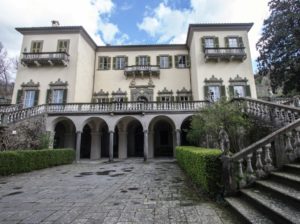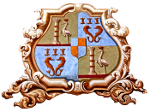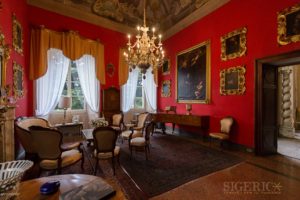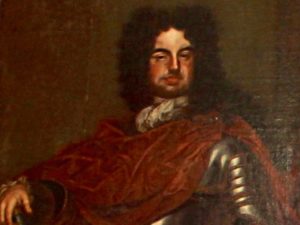The “Villa of Chiosi” was constructed during the last years of the seventeenth century by the brothers Carlo and Francesco Dosi, two rich business men who had found in Pontremoli an ideal place where the trade among the Leghorn harbor and the Po Valley (italian: Pianura Padana) were flourishing .
The history of the mansion is tied to the history of the Dosi family, which has always been connected to this place, from its construction to the present day: it went through periods of splendor ,neglect, and finally restoration, through which we can admire today the Villa in all of its glory.
History of the Dosi family

The first historic information about the Dosi family are related to the pledge of allegiance that was made in Modena in 1168 by some family members and to their participation to conflicts for territorial supremacy, which took place in that city during the XII and the XIV centuries. Then, the family moved to Bologna and later to Belgioso in the province of Pavia; in 1496, a Guglielmo moved to Pontremoli as a commander of the Sforzesco Castle of Piagnaro.
In the following decades, the Dosi family began a lucrative trading activity between Pontremoli, Leghorn and Piacenza and in a short period of time, they reached a remarkable welfare.
In the meantime, through cautious wedding politics, the family tied itself to the most important local houses. The full recognition of the family in Pontremoli happened at the end of the first half of the XVII century, when Carlo’s son, Nicolò Dosi (1619-1669) was admitted to the General Council of Pontremoli.
In the last decades of the 17th century, the heirs of the wealthy merchant Nicolò Dosi, Carlo and Francesco, had the so-called “Casa dei Chiosi” built and decorated.
The two brothers present themselves to visitors at the entrance to the villa, accompanied by the family coat of arms (a stork, a tower, two dolphins) and cartouches with the symbolic date of the building’s construction, 1700.
The idea and the design of the villa are linked to the figure of Carlo Dosi, a man of great culture with a passion for art, architecture and gardening, who chose some of the most important artists of the time to decorate his “home”, such as the Lombard architect and decorator Francesco Natali and the Tuscan painter Alessandro Gherardini.
After Carlo Dosi’s death in 1724, his son Giuseppe Antonio Dosi (1679-1769) continued the family business with great enterprise, but he shifted his interests and finances to the construction of the Palazzo Comunale. During these years Giuseppe Antonio devoted himself to politics and business, seeking an increasingly influential social position, becoming a marquis in 1733.
In 1724, Carlo Dosi died and the interests of the family were conducted by his son, Giuseppe Antonio Dosi (1679-1769) with great initiative, though he moved his interests and his financial resources into the construction of the city palace. In these years, Giuseppe Antonio focused on policy and affairs, in order to occupy a more influential social position, becoming marquise in 1733.
With the generation following that of Giuseppe Antonio, the descendant parabola of the family began: as the economic conditions in Pontremoli became less favourable, the descendants found themselves involved in numerous inheritance issues and disputes. This dynamic led both to the fragmentation of the estate and the villa, and to a decisive patrimonial crisis for the family itself.
The abandonment of the house, a decade before the French Revolution (1789-1814), was the culmination of this affair.
In the nineteenth and twentieth centuries the family’s fortunes gradually recovered, thanks to personalities such as Gian Simone (1790-1854), Gian Carlo (1824-1915, remembered for presenting the results of the plebiscite for the annexation of the Duchy of Parma and Piacenza, then the Kingdom of Sardinia, to King Vittorio Emanuele II, together with other personalities such as Giuseppe Verdi) and his son Andrea (1863-1924).
Not without difficulty, the conditions were created for Gian Carlo (1896-1979) and Pier Andrea (1928-2020) to complete the work, which was completed in the 1990s.
 History of the Villa
History of the Villa

The visitors are welcomed by the two busts of Carlo and Francesco Dosi, located above the main portal of the edifice; they were the creators and principals of the mansion. From the cartouches located under the portraits of the two brothers, we learn that the mansion was constructed in 1700.
Actually, the date, has to be considered as an indicative one: some documents and testaments of the family that have been recently analyzed, lead us to believe that the idea for the project of the mansion had already been made around 1660-70. From the documents it appears that in 1693 the Dosi Villa, defined as “fabric” and “palace with garden”, was already covered and that there were people who provided it with statues and decorations.
On one hand, we know with certainty the names and the roles of the people who wanted to construct the Dosi Villa. On the other hand, we had no information about the identity of the architect who designed it or about the workforces who realized it. Francesco Natali, the architect and painter from Cremona who studied at Bibiena school, and Alessandro Gherardini, a famed artist from Tuscany who was very active in Pontremoli, were invited to execute the decorations for the internal spaces. These decorations are generally assigned to Natali; they feature the typical architectural views which will become a stylistic hallmark of Pontremoli’s Baroque during all the first half of the XVIII century.
The paternity of the frescos inthe main hall is assigned to Gherardini. These frescos however are, unfortunately, largely lost. While Alessandro Gherardini worked at the Dosi Villa between 1697 and 1700, Francesco Natali worked there for the first time in 1697, remaining involved for a decade.
The family tradition ascribes to Natali also the plan of the bridge and of the Chiosi chapel. Here, an epigraph testifies that the bridge was erected by Carlo Dosi in 1705 “ad solum proprium usum eiusque heredum” (reserved only for him and the heirs.)
Completely abandoned during the years of French Revolution, the Dosi Villa was progressively recovered beginning in 1814 and is still object of restoration today.
“Those 30 years of abandon have left indelible traces on the frescos of the hall, which are in large measure irretrievably lost, are furniture, decors, doors, statues and even the big front gate, that was replaced in the XIX century.”
This is what Pier Andrea Dosi Delfini writes in one of his diaries. Slowly, the family redecorate the house, frequently buying (or buying back) paintings, furniture, lamps from other families of Pontremoli or through a careful search on the antique markets. During the Second World War, the Villa was subject of multiple raids by the Allied forces in order to find a German command that was guarding a cannon in the nearby rail tunnel. Clear signs of such bombardments, which damaged the mansion, still exist inside the hall.
Old statues, tall trees (magnolie and holm oak) and numerous lemon trees decorates the south side rooftop garden of the Villa. Above, there is a panoramic viewpoint which offers a marvelous view of the house and of the surrounding landscape.
The Lebanese cedars are very impressive. Imagined as a place for social events according to the taste of the Baroque time, the Villa represents the spirit of its time at its best, through a surprising interweaving of nature, architecture, artistic decorations and fine furniture. The building develops on a hillside and it is constituted by a central block that comes in the shape of an “H” which is flanked by two roof gardens and framed by terraced vineyards. In 1988 The Villa was recognized as a place of significant historic and artistic interest. It is from here that the innumerable restorations started in 1991-1993 thanks to which today we can now admire this extraordinary site.
To discover more about the garden, click here!
To discover more about the great hall and the rooms, click here!
 Distinguished Visitors
Distinguished Visitors

Francesco Farnese, Duke of Parma and Piacenza, and his wife Dorotea Sophia di Neoburg, visited the villa in Pontremoli in 1714 on their return from their journey to accompany their daughter Elisabeth, who had married Emperor Philip V of Spain. In fact, the Duke showed his intention to “go to Pontremoli for the sole purpose and effect of seeing his Villa dei Chiosi”.
The villa, still unfinished, received them with pomp and circumstance. The chronicles of the Villa tell of the stay of these illustrious visitors:
Her Highness arrived at the said Villa on Friday 28th September at about 10 p.m. with a retinue of ladies, cavalry, pages, secretaries, chambermaids, carabinieri and all the rest of the lower family, with a stable of one hundred and fifty horses […].
The chronicle of this important visit gives us a truly interesting insight into the customs and habits of 18th century society. It was the heirs of the Farnese dukes, more precisely Elisabetta’s son, who bestowed the title of marquis on the members of the Dosi Delfini family.